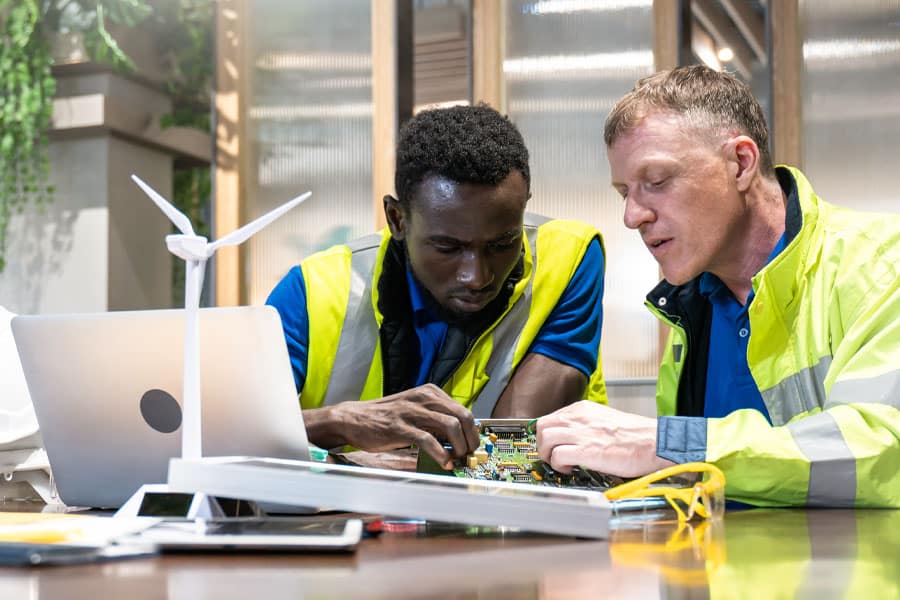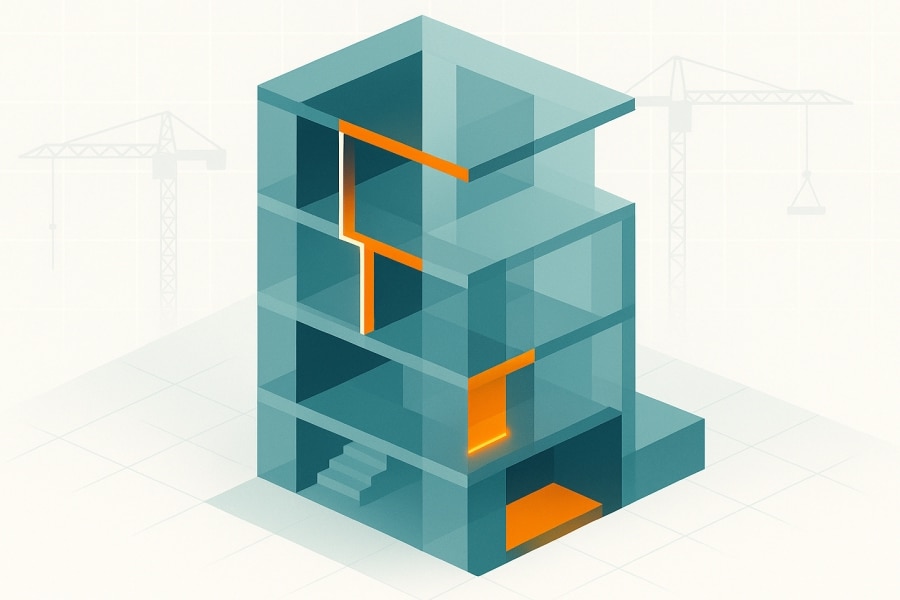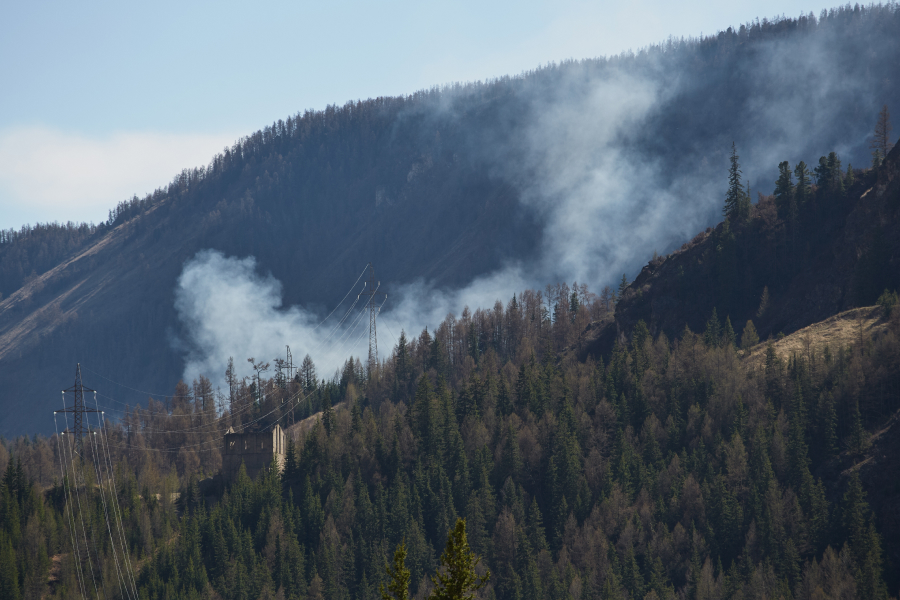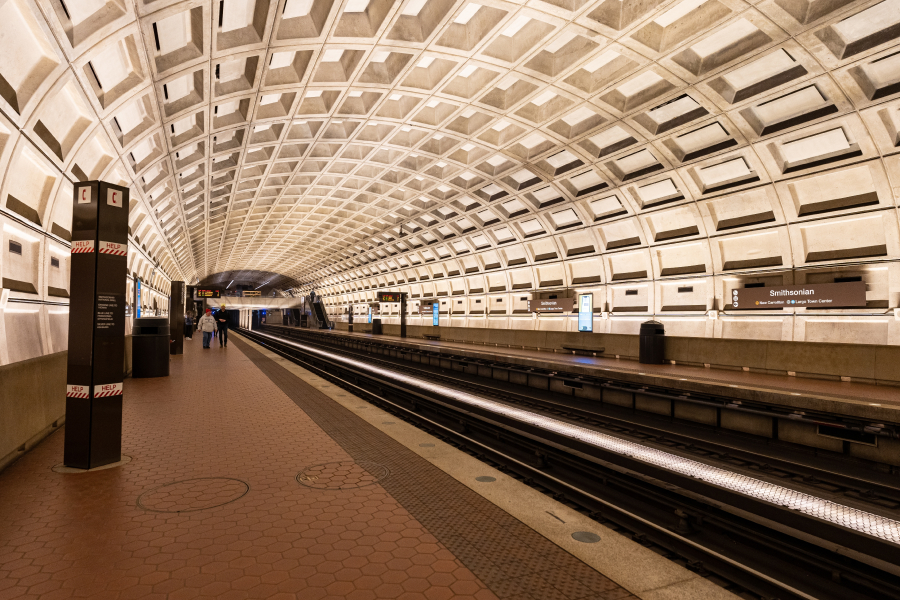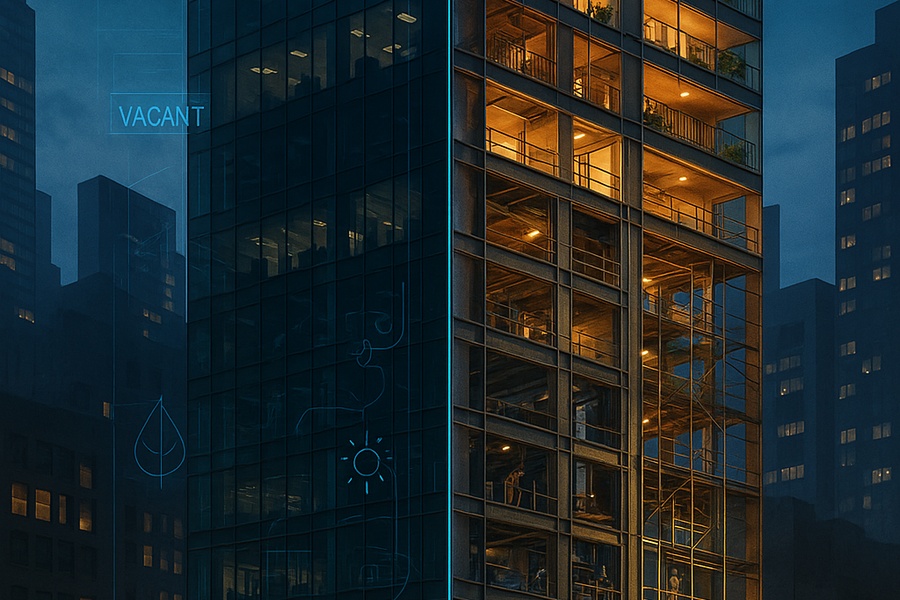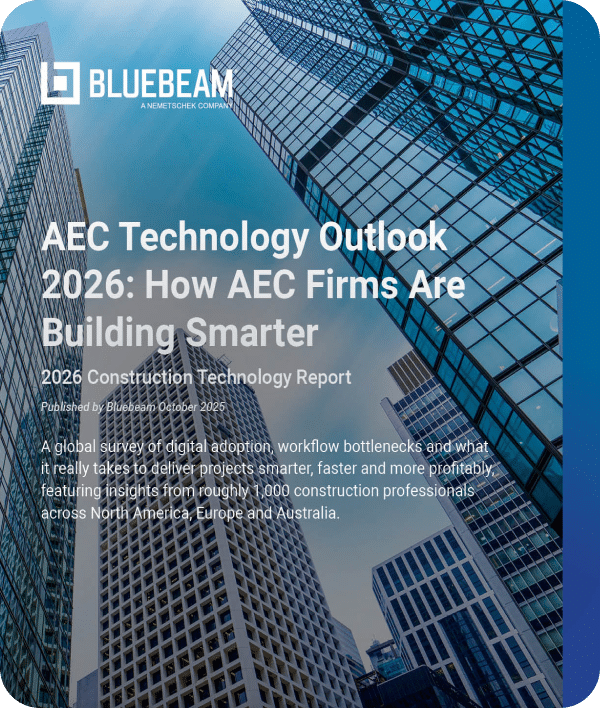Worldwide, construction activity and the operational element of the built environment account for around half of greenhouse gas emissions.
In the UK, the built environment – buildings and infrastructure – is currently responsible for 25% of total greenhouse gas emissions, and including surface transport, such as vehicles delivering materials and other supplies, increases the industry’s total share to 42%.
Such levels must decrease if industries, communities and governments around the world are committed to tackling climate change. Thankfully, the construction and engineering sectors recognize the need to align with net-zero objectives. This is partially driven by government, which is a major client of infrastructure and building projects.
What can engineers do to aid the fight against climate change? Some take a holistic view. Tim Chapman, director of infrastructure design at Arup and a member of the Institution of Civil Engineers’ Decarbonisation Community Advisory Board, believes there needs to be systemic change across the country and the domestic economy – from energy generation to how we view transport systems, place and our landscape – for engineers to be able to play their part in meeting ambitious climate goals.
Bluebeam spoke to Chapman about how engineers can strive towards making engineering net-zero to contribute to a better climate and a cleaner environment.
Built Blog: What’s your perspective on net-zero as an engineer focusing on infrastructure?

Chapman: “An awful lot of infrastructure is meant to be transformational. If you’re building a bank, it’s actually very good that you make that bank net-zero, because a bank is a private organization making its own profit. But if you’re building a new railway, or a new hospital, or a new power station, it’s actually about being for the public good. Everything should be part of a net-zero journey, but it doesn’t necessarily have to be net-zero in itself. I’m very close to University College Hospital, which has a big proton beam accelerator there to treat cancer. The notion that that should be net-zero to treat cancer is probably quite offensive – we need to spend our scarce carbon on only the most virtuous activities – and I can’t think of anything more deserving. By all means, we need the whole economy to be net-zero, but we need to make sure we still do good things for society in that new paradigm. I’m involved in Hinkley Point C and Sizewell C power stations; they’re never going to be net-zero in themselves, but they allow us to turn off all the coal-fired and gas-fired power stations. So while they’re not net-zero, they’re actually huge steps in the direction of the whole economy becoming net-zero.
“When you come to systemic things like infrastructure, the whole emphasis changes. Take the example of a new underground railway. Its most fundamental aim is to get people out of cars and get them to use public transport instead. This is not only lower carbon, you are getting people to become more engaged in society, you help create places for shops to thrive in a post-pandemic world. Lots of good things come about for society by having people traveling on public transport. But if you try too hard to make that underground railway net-zero, you wouldn’t build it at all. And net-zero can’t be seen in isolation of, say, the biodiversity emergency and protecting overall nature. A lot of people’s response to net-zero is ‘I will/might reduce my carbon a bit, and if it comes down to it, I’ll pay an offset.’ That offset can be used to pay for a monoculture plantation of alien trees, whose trees do little good for biodiversity. The forest produced doesn’t thrive as well as deciduous forest, which sequestrates carbon over a far longer period of time. So actually, the right answer is ‘Let’s produce a native deciduous forest that enables a much richer range of nature to thrive.’ And then once a deciduous forest has grown and is populated with all these and other plants – everything else that actually goes in – it’s a place where people can go and enjoy nature.”
Built Blog: So we need to take a holistic approach?
Chapman: “The planet is the key issue. Within that, you can break it down, country by country. In the UK, we have what are called our consumption-based emissions and our territorial emissions; territorial emissions are what we actually create here, and consumption-based includes what we import. Our territorial emissions have been falling very quickly, and for two reasons: first of all, our grid is now vastly more efficient than it was. Our electricity is much greener than it was 10 years ago, plus we’ve offshored much UK manufacturing. A lot of the stuff we buy now gets made in China and elsewhere, so it’s on other countries’ carbon books rather than ours. We’ve offshored manufacturing out to places where the electricity generation is often dirtier than ours. Is the planet better off by us offshoring? It’s debatable. When it comes to the UK, the critical issue is how we change our systems to get to net-zero.”
Built Blog: Is offsetting a false flag?
Chapman: “The issue from an infrastructure point of view is that we just need to now replace our systems quickly to get to net-zero, so there is a problem with offsetting. Somebody once said offsetting is a bit like having an affair but paying a priest to be celibate on your behalf. Offsetting doesn’t change the root behavior. The right approach is to try to change the ways you do things, and then with the final bit of ‘residual sinning,’ where there’s no way you can get rid of the emission element, that is what you offset. To give you an example, the A14 in Cambridgeshire, which is a big new road, created about a million metric tons of CO2. To offset a million metric tons of CO2, you’d need to plant a forest the size of London, about 30 square kilometers (12 square miles). So if we try and offset by planting trees, there simply aren’t enough trees and there’s not enough space for those trees on the planet. The better approach is that we produce a different transportation system that actually is far less carbon-intensive in the future.”
Built Blog: How do you assess an asset’s carbon?
Chapman: “Each asset has three carbon elements: capital – construction – carbon, operational carbon and user carbon. As an asset owner, if I own Heathrow, I control the capital carbon and the operational carbon elements, but I can only influence the use of carbon, the type of planes that use the airport. Likewise with a road or a railway line. Most emissions due to transport are in the ‘use’ component. The critical issue is what we do to reduce these ‘use’ emissions. So getting to net-zero means all of these need to come down to a very small number, and only then we offset the rest. But again, the better approach is to change how people travel around. At the moment we use cars far too much. Yes, these are becoming electric-powered, but a city full of electric cars is almost as dystopian as one full of fossil fuel-powered cars. We need to make cities more livable, and cars are a very inefficient way of moving people within them. With cities becoming increasingly congested, the right answer is to have more public transport running much more efficiently, plus, of course, a greater reliance on bikes and walking. But it’s essential to recognize that what we’re talking about is a vastly different future paradigm compared to what exists today.”
Built Blog: What are the responsibilities of engineers in the efforts to reduce carbon?
Chapman: “Engineers can sometimes get lured into ‘doing the wrong thing well.’ Therefore, we need to be able to challenge the projects we get involved in. As engineers, we try and shape the projects with the clients at an early stage. We also need to choose the products that we work on because, morally, our decisions of today will be judged by the standards of 2030.
“I would like to believe that people should almost be required to pay a premium if they wish to do the ‘wrong thing.’ A lot of investors are now divesting themselves of oil and gas assets, but there’s a really big secondary market now of vulture capitalists mopping up those quite profitable companies, and who don’t really care about doing it. Wouldn’t it really be good if we had some sort of ‘race to the top’? Not a race to the bottom? Wouldn’t it be really good if more people tried to do the right thing? Engineers are the ideal advisers to be there at the very beginning of schemes to help clients shape what they’re doing. If we just leave it to economists and other people, and we just turn up later on to design what has been decided upon by others, we’re abdicating a really important place at the table.”
Built Blog: So can project developers play an important role?
Chapman: “Yes. A few clients, for example HS2, are doing a lot in this area, incentivizing their supply chain to bring in huge reductions in the capital carbon element of a scheme. We accept the fact that HS2 is a good thing for low carbon, since it’s about getting people to move onto public transport, it’s actually increasing capacity in the country, which means we can interlink our cities more, we can share prosperity better. But we should still try and make the capital carbon for such a project as low as possible. And HS2 was really good because it set some really challenging carbon targets for the supply chain. That spurred a huge industry of companies working with universities, researching new low-carbon cement so as to ensure we can have lower-carbon concrete. So this audacious goal is paying great dividends. But most of the big UK infrastructure clients get this. They’re also encouraged by the regulators to reduce carbon. Someone like Thames Water is allowed — in their case by Ofwat (the water services regulator) — to charge people a bit more to reduce the carbon of your systems. In this way everything can move in a more virtuous direction.”
Built Blog: Is it possible to come up with a net-zero engineering strategy that could be applied across the board? Or is it project-specific?
Chapman: “There basically needs to be big systemic change. If you wait for every building to be part of its own little solution, you won’t decarbonize the whole economy. There are three big areas where we need to decarbonize – transport, heat and energy generation, and changing the whole nature of the grid. We’ve got 27 million homes where the heating system needs changing. And if you divide 27 million homes by the 28 years between now and 2050, that is a very big number of homes to fix per year, per month and per week. Look at the size of the industry that needs to be created, the number of people to be trained, the equipment to be bought. It is absolutely huge.
“Likewise, in a transport system, you’re not going to go and change the road outside your house individually. We need society to provide an entirely different transport network.
“Similarly, how we decarbonize the grid, we don’t need people to go out and build their own little green power station. Where once we thought that microgeneration was the answer, now we know the only way to decarbonize the grid in a significant way is by big systemic changes, with huge amounts of renewable power on the grid, and some power that doesn’t depend on the vagaries of the weather, the need to have nuclear power stations to provide low-carbon baseload power, so that when the wind’s not blowing and it’s not sunny, you still can actually make sure your power is flowing.
“It also goes beyond things like having carbon capture and storage attached to our remaining fossil fuel power stations; we need to have things like direct air capture, where a whole new industry basically sucks CO2 out of the atmosphere to help restore the balance. To arrive at such a place requires change at a systemic level. We need the right incentives on a national level, not to fill our land with monocultural conifers, but to deliver native deciduous woodlands supporting a wide variety of nature, where adjoining infrastructure blends in.”
Built Blog: Are you optimistic for the future?
Chapman: “I think we’re moving huge in the right direction, and more and more people are getting it. And as I’m an optimist by nature, I’m actually quite hopeful. However, humanity is better at solving an immediate crisis than a slightly longer-term one. One of the issues with climate change is that it’s a huge existential crisis, but it’s happening a bit too slowly for humankind to react in the way that we need humans to react. We want basically the same sort of reaction that happened in WW2 in terms of defeating the threat posed by the Nazis, or even more recently, with the Russian invasion of Ukraine.
“Humanity can be amazingly imaginative and creative when it takes resolute action, and many people can sacrifice a huge amount of important things for the cause. Once humanity has truly realized the magnitude of the task, yes, we will respond to it. Unfortunately, we’re not at that point with climate change, because too many people still presume the bullet is coming at us too slowly and we don’t need to dodge it yet. But I think that those days are coming. And at that stage I’m hugely optimistic about the ability of humankind to solve the really big technical questions.”

